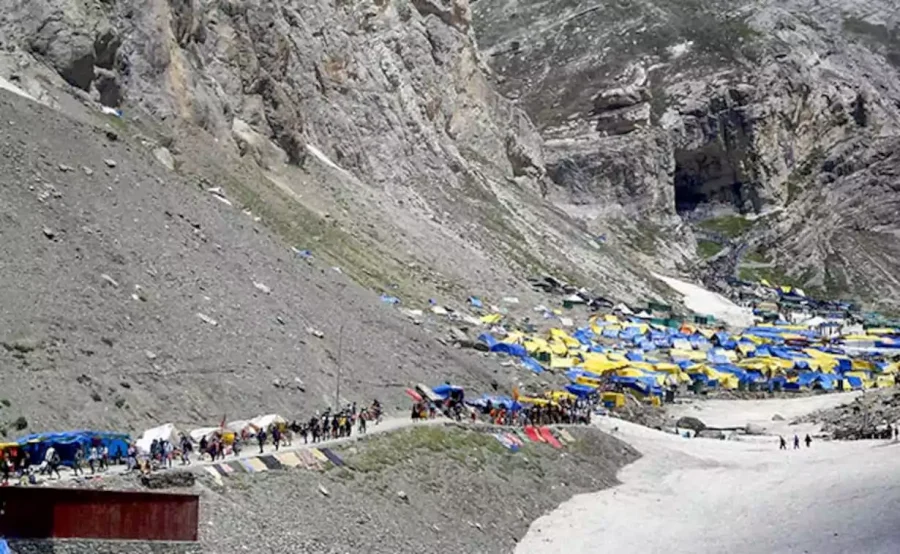Humayun Aziz Sandeela
The Amarnath Yatra, an annual Hindu pilgrimage to the Amarnath Cave located at an altitude of 3,888 meters in the Himalayasin Indian illegally occupied Jammu and Kashmir, attracts hundreds of thousands of devotees each year. Although this significant religious event has both cultural and economic importance, but it also has raised environmental concerns, particularly regarding its impact on the fragile ecosystem of the region.
The Amarnath cave is home to an ice stalagmite revered as a physical manifestation of Hindu deity, Lord Shiva. The pilgrimage occurs over 45 days in the summer when the cave is accessible.
Despite efforts by the Dogras to popularize the Amarnath Yatra since the late 19th century, it never fully integrated into the social fabric of Kashmir, even with a significant presence of Kashmiri Pandits (Hindus) in the region, their participation remained insignificant. But since the 1980s, the yatra has experienced a significant resurgence.
Since 1963 India meticulously started gathering data on the number of yatris, with a particularly remarkable surge observed between 1980 and 1985. Official data shows that the number of worshippers rose from 4,500 in 1950 to 353,969 in 2013. In 2019, despite the pilgrimage being shortened to 32 days, 342,883 people visited the shrine. According to a report by the Times of India, the cave was visited by a total of 304,000 visitors in 2022 while in 2023 more than 428,000 pilgrims took part in the Amarnath Yatra.
This dramatic rise coincided with the emergence of far-right Hindu militant groups in India. During this period, the Vishwa Hindu Parishad (VHP) and its subsidiary Bajrang Dal were particularly active in reviving Hindu nationalism. In the case of the Amarnath Yatra, this revival was achieved in two key ways. First, government support, which had been minimal until then, became crucial in ensuring the yatra’s success and smooth execution. Second, the duration of the yatra was gradually extended to encourage greater participation from across India, which reached 63 days in 2023.
In the 1990s, efforts were made to align the pilgrimage with an Indian nationalist agenda, countering Kashmiri demands for independence from India. In 2001, the Indian government solidified its control over the yatra by establishing the Shri Amarnath Yatra Shrine Board (SASB). This move asserted state patronage and ownership, ostensibly to provide essential amenities to the yatris.
The establishment of the Board not only ensured state patronage but also served as a facade for the deployment of Indian armed forces. It became a mobilization tool, encouraging people across India to participate in the Yatra and demonstrate their loyalty to the nation. The religious nature of the Yatra was transformed into a symbol of national pride, as highlighted in a 1997 Press Information Bureau Feature Release.“Faith can move mountains, so goes an old adage. With a little variation to the saying, it is hoped that the yearning for Moksha (salvation) can move the devotees to the challenging heights of Kashmir. This will also be a befitting gesture of solidarity with our valiant soldiers who have been fighting the enemy to defend our borders.”
In 2008, the Government of India proposed transferring 100 acres of forest land to the SASB for constructing huts and other infrastructure for Amarnath yatris. This proposal raised suspicions among Kashmir’s pro-freedom leaders, who believed it was an attempt to settle non-local Hindus in the region. This suspicion led to a two-month-long agitation and widespread protests throughout Kashmir. Over 100 civilians were killed, and more than 1,000 protesters were injured. The widespread protests forced the Indian government to shelve its plan for the land transfer to the SASB.
Environmentalists have time and again raised concerns over the unregulated influx of visitors to Amarnath citing Jammu and Kashmir’s sensitive environment and its crucial role in providing water and environmental stability. In the wake of these concerns, in 2012, the Supreme Court of India constituted a Special High-Power Committee. The committee acknowledged the fragility and vulnerability of the ecosystem, emphasizing the importance of calculating, minimizing, and controlling the impact of human activities, but these suggestions have never seen light of the day. The committee also neglected to address vital issues such as noise pollution and the substantial impact of heavy footprint of humans on glaciers, the Lidder and Sindh Rivers, and the surrounding forests and meadows.
Despite the longstanding environmental concerns associated with the yatra, the SHPC focused on yatri safety rather than environmental issues. Previous committees, such as the Sengupta Committee of 1996 and the Mukherjee Committee of 2000, were also established to ensure yatri safety. These committees recommended regulating the number of yatris traveling through the fragile landscape daily.
In 2006, the Jammu and Kashmir Pollution Control Board released a report highlighting critical environmental issues and reinforced the importance of controlling the daily number of pilgrims on both pilgrimage routes.However, these recommendations have never been implemented, neither for yatra safety nor environmental protection, suggesting that the journey’s purpose extends beyond a mere religious pilgrimage.










